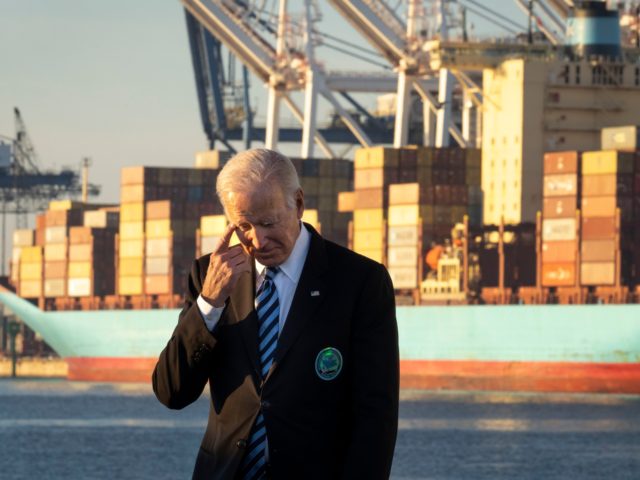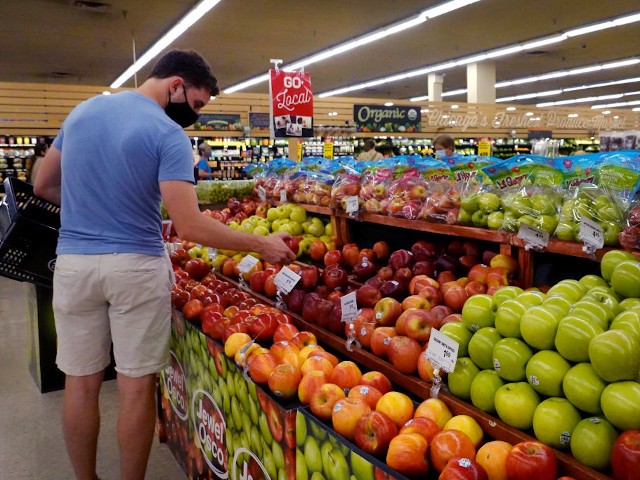DURING COVID, THE WEALTH OF THE 1% BILLIONAIRE CLASS ALL BUT DOUBLED. HOW WELL ARE YOU DOING?
The surging cost of living and the class struggle
The price of goods and services used by US households increased 6.2 percent over the past year, according to data released Wednesday by the Department of Labor. This is the highest increase since 1990. In October alone, the cost of key goods rose by nearly 1 percent.
But official inflation statistics only begin to tell the story:
- Groceries have increased 5.4 percent year over year. In particular, the cost of bacon is up 20 percent, beef roasts, 25 percent, and the index, generally, for poultry, fish, eggs and meat 11.9 percent.
- Fast food prices have increased 7.1 percent compared to last year. Full-service restaurant prices have increased 5.9 percent.
- The cost of filling up on gas at the pump has risen by 49.6 percent over the last 12 months. According to the AAA, the nationwide average was $3.42 per gallon Tuesday, up from $2.11 last year.
- Energy prices as a whole have risen by 30 percent. The US Energy Information Agency predicts that households will spend 43 percent more on heating oil and 30 percent more on natural gas this winter.
- The cost of vehicles has increased significantly. Used cars are up 26.4 percent, new vehicles are up 9.8 percent, and rental cars are up 39.1 percent.
- Other important increases include appliances (6.6 percent), hotel and motel rooms (25.5), furniture (12), moving and freight costs (7.9), postage (7.2), garbage and trash collection (5.3), tobacco (8.5), computers (8.4), sporting goods (8.7), cameras and camera equipment (5.5), as well as dry cleaning (6.9).
While average hourly earnings are up 5.1 percent compared to last year, inflation is higher. When placed against it, wages are down 1.1 percent—a pay cut for the typical worker.
What is more, increases in consumer costs are disproportionately borne by poorer sections of the population. A dollar more per gallon of gas weighs far more heavily on a worker making $19, the 2019 median wage, than it does on the rich.
Workers cannot afford these increases. A March poll from Jungle Scout consumer report found that 56 percent of Americans were living paycheck to paycheck. This week, the Federal Reserve announced that US household debt rose to a historic high of $15.24 trillion. This was driven by credit card debt, auto loans and student loans.
Commenting on these developments, CNN wrote, “Now that the stimulus sugar rush has worn off, consumers are going back to their old ways of spending with their credit cards.” Although framed in the callous and indifferent language typical of the US media, this statement points to a basic reality: the modicum of financial assistance that allowed workers to survive amid the pandemic has been ended, and working-class families are forced to pay their surging bills by borrowing.
The present surge of inflation arises from the intersection of the crisis triggered by the pandemic with the decades of policies promoting the growth of social inequality.
For decades, the US government and political establishment sought to overcome the crisis of American capitalism through the impoverishment of the working class, coupled with the provision of unlimited cash for the financial elite.
In 1979, the Carter administration appointed Paul Volcker to the chairmanship of the Federal Reserve. Volcker moved to raise interest rates to historic levels in order to break the resistance of the working class.
With the election of Reagan in 1980 this assault was intensified. Gaining assurances from the AFL-CIO that the unions would not interfere, Reagan crushed a strike of air traffic controllers in August 1981. The betrayal by the AFL-CIO initiated a wave of defeats for workers, as the trade union bureaucracy morphed into low-wage labor contractors, functioning to police the working class for the benefit of their increasingly wealthy and corrupt executives.
But the underlying economic crisis of American capitalism driving these policies only deepened. The Federal Reserve encouraged speculation and debt to keep asset bubbles going. In crisis after crisis, beginning in 1987, the government intervened to buy toxic assets, lower interest rates, and funnel money into financial markets. The wealth of the upper classes ballooned, tethered to rising stock prices.
This policy came to a head in 2008. Toxic subprime mortgage assets in the US imploded, engulfing the entire world economy. In response, the Federal Reserve, and other central banks, took unprecedented measures to prop up capitalist markets. Bush and Obama funneled trillions of dollars into financial markets, bailed out Wall Street directly, refused to prosecute those responsible, and restructured American manufacturing by gutting pay and benefits in the auto industry.
By 2020, the trillions of dollars of cash injected into financial markets in response to 2008 had led to record highs in the stock market.
While the pandemic temporarily disrupted these gains, the response of the ruling class has been to orchestrate another massive bailout of the rich. The Federal Reserve initiated an emergency program of asset purchasing. Some $4.5 trillion of digitally printed money has been used to prop up financial markets. Asset purchases continue to the tune of $120 billion every month. In addition to this, the CARES act, which cost $2.3 trillion, was largely a bailout of major corporations and businesses, many of which received billions of dollars in direct aid.
This free money has fueled a massive inflation in the value of all financial assets and the wealth of the rich.
The financial oligarchy that dictates social and political life in the United States is determined that the entire burden of the crisis triggered by the pandemic should be borne by the working class. This overriding concern led to the coverup of the dangers posed by COVID-19 in early 2020, then the systematic abandonment of public health measures beginning in late March, followed immediately afterward by the slashing of emergency jobless aid, with the aim of forcing workers to accept any job, no matter how unsafe or low-wage, that they can get.
But despite the ruling class’s efforts to force workers into disease-ridden factories and warehouses, the pandemic, coupled with the international tensions it intensified, has had a major impact on global supply chains. Many workers with health conditions, or whose family members are immunocompromised, have chosen not to return to poverty-wage jobs amid a raging pandemic.
The ruling class is concerned that the growing demands of workers for higher wages, expressed in both strikes and the so-called “great refusal,” that is low-wage workers leaving their jobs, has led to significant labor shortages in key sectors.
The surging cost of living has propelled the largest strike wave in decades, including major struggles at Volvo, Deere, Dana and elsewhere.
In each of these struggles, the workers confront not only their employers, but the trade unions, which have worked to systematically isolate, sabotage and shut down every strike. If these organizations of scabs had their way, the class struggle in 2021 would proceed the way it had in decades past: with plummeting wages, mass layoffs and soaring corporate profits.
But at factories, hospitals and schools across the country, new rank-and-file committees are forming which represent the genuine interests of workers. To succeed, these organizations must, through coordinated action, break through the isolation imposed on them by the trade unions. This means forming bonds and links with workers in other sectors, other states and, critically, other countries.
Faced with the growth of the class struggle, sections of the political establishment are considering solving the “labor problem” by force, with Biden saying last month that he is considering deploying the National Guard to “get the ports up and running.”
Since the start of the pandemic, the US ruling class has sought to ensure that the entire cost of the crisis, whether in death or economic suffering, must be borne by the working class, even as the world’s billionaires pile up immeasurable fortunes.
But enough is enough. It is not America’s exploited and impoverished workers—who have been told for decades that they must accept layoffs and pay cuts for the good of American industry—but America’s financial oligarchy that must bear the cost of a health, social and economic crisis created by American capitalism.
Joe Biden Finally Admits Inflation Is ‘Worrisome,’ Three Months After Dismissing It as ‘Temporary’

President Joe Biden conceded Wednesday that inflation was a problem, three months after dismissing it as temporary.
“Everything from a gallon of gas to loaf of bread costs more,” Biden said during an event promoting his infrastructure bill in Baltimore. “And it’s worrisome, even though wages are going up.”
The president took a sharply different tone from his comments in July, when he dismissed rising costs and inflation as temporary and nothing to worry about.
“Some folks have raised worries that this could be a sign of persistent inflation. But that’s not our view,” he said at the White House on July 19.
“Our experts believe and the data shows that most of the price increases we’ve seen are, were expected and expected to be temporary,” he continued.
In July, the annual inflation rate was 5.4 percent after it hit five percent in May, and 5.4 percent in June. The annual inflation rate was still at 5.3 percent in August and 5.4 percent in September.
All along Biden tried to downplay its impact in the hope it would simply go away:
It didn’t.
In October, the inflation rate hit 6.2 percent, up 0.9 percent from just a month earlier marking it as the highest rate since November 1990.
But Biden tried to argue the rising cost of goods was somehow only proof of how his policies were working.
“Because of the strength of our economic recovery, American families have been able to buy more products,” he said.
Biden argued Americans had more money than ever thanks to his child tax credit and the one-time $1,400 checks passed in March.
“But what happens if there’s nothing to buy and you got more money?” Biden asked. “You compete for getting it there. It creates a real problem.”
Biden tried to reassure Americans that he had spoken to CEOs of some of the largest companies in America who told him that things were going to be ok.

Customers shop for produce at a supermarket on June 10, 2021 in Chicago, Illinois. Inflation rose 5% in the 12-month period ending in May, the biggest jump since August 2008. Food prices rose 2.2 percent for the same period. (Scott Olson/Getty Images)
Buț corporate executives are privately warning the president and his administration that they are still not taking the issue seriously.
“I don’t think the administration is on top of it at all,” a CEO of one of the U.S.’s largest companies told Politico on condition of anonymity. “How many people inside this White House really know what inflation is or how it impacts businesses? It’s not really their fault. It’s been so long since we really had it.”
Biden also faces dissent from his own party, as Sen. Joe Manchin (D-WV) pointedly noted that the inflation Americans were experiencing is obviously not temporary.
“By all accounts, the threat posed by record inflation to the American people is not ‘transitory’ and is instead getting worse,” he said in a statement. “From the grocery store to the gas pump, Americans know the inflation tax is real and DC can no longer ignore the economic pain Americans feel every day.”
No comments:
Post a Comment